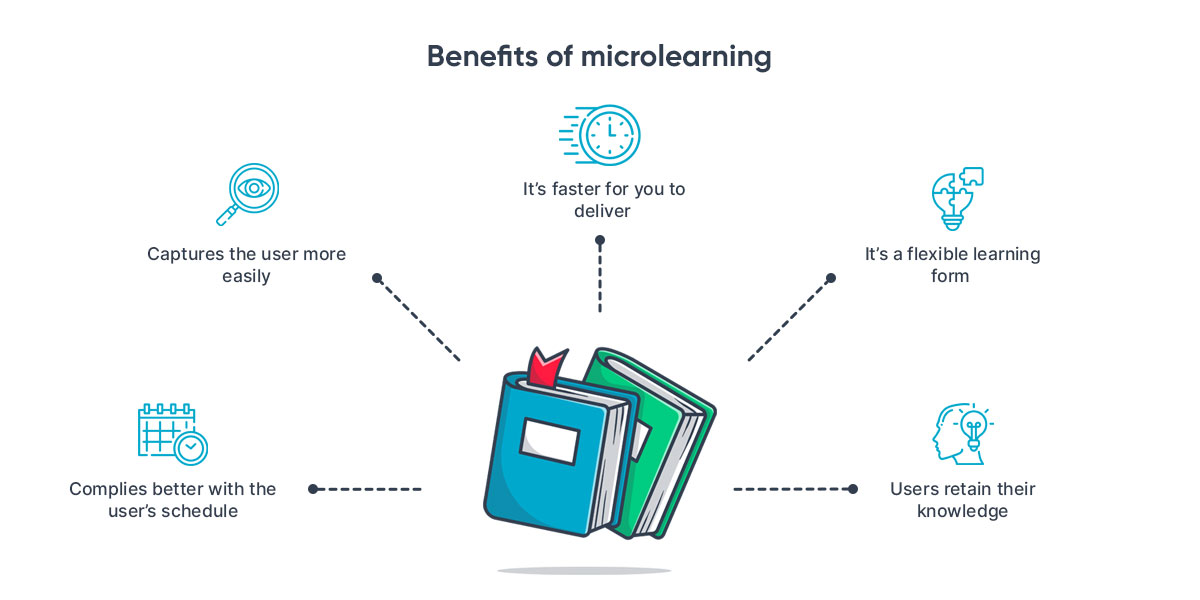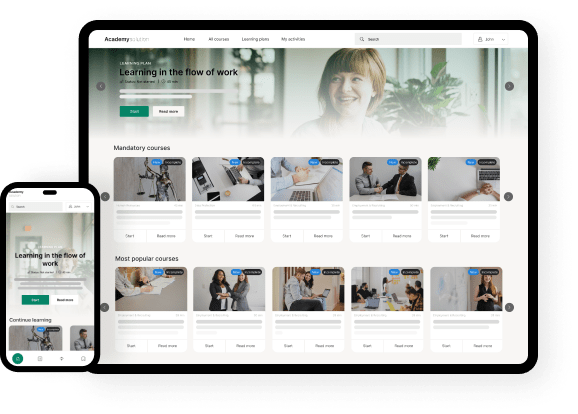Do you have an online academy, or are you in the start-up phase of creating an e-learning platform? No matter where you are in the process, there will always be things you can optimize on. Have you for example considered what kind of courses and formats provide the most effective results? Microlearning is a great example of how to get an effective learning format into your e-learning platform.
In this guide, we’ll help you grasp the concept of microlearning and see why it’s advantageously for you to add it to your e-learning strategy. We also provide concrete examples of what microlearning is. In short: We’ll hand you all the answers on a silver platter – bon appetite!
Microlearning: Learn more in less time
The modern man has limited time to learn new things. Between busy work tasks, short deadlines, picking up children from daycare institutions, and exercising, it can be difficult to find the time or surplus to learn new things. This can pose as a real challenge for you if you’re running an online academy or an e-learning platform. Because how do you create learning content that fits into the busy employee’s tight schedule? Here, micro-learning is an obvious format.

But what is the definition of microlearning? It lies in the name: micro-learning. That is, short sessions of learning or small chunks of knowledge that are consumed when the user has time.
In the same way, let us divide the concept into smaller chunks. As you’ll see in the below, it’s several small parts that together make up microlearning.
- It’s short and good
The most important aspect of microlearning is the content being short and quick to get through. The short courses must be easily accessible to users. Learners should be able to access the content at anytime and anywhere. This means, among other things, that you must ensure that the course can be accessed from several different devices.
- It’s engaging
E-learning should always be engaging so users will stay motivated to learn. The short format makes this easier seeing very few can stay concentrated for longer periods of time. This way, the user can switch between topics, but still succeed in completing multiple tasks. The short format also allows you to create content that to a higher degree captures the user – take for example short quizzes and quick videos.
- It has only one learning purpose
The typical microlearning format has only one purpose. That way, the user stays focused on that exact topic, which is necessary when it comes to short courses.
Specific microlearning examples
Another thing that characterizes microlearning is that it can take many different media formats. The microlearning examples thus depend on the media format. Some examples of media formats are images, infographics, text, games, video, and quizzes.
As long as it’s kept short, you’re well on your way. If it’s text, make sure it’s short sentences or paragraphs. If it’s sound, let it be short bits of speech or music. An important takeaway, though, is that you shouldn’t take existing content and break it up into smaller bites. This way your content can become fragmented. Instead, create short and focused content from scratch to make sure you get the best results.
Some examples of interesting microlearning are:
- Summary quizzes on a specific topic – for example, how to use Microsoft 365.
- A video presentation used in pre- and onboarding situations – for example, a presentation of the company’s values, management or compliance.
- Interactive questions and answers like a drag and drop system.
All the above examples help keep the user engaged and motivated for shorter periods at a time.
All the benefits – why use it?
Microlearning brings a wealth of benefits such as faster delivery and increased user motivation. Have we not convinced you with these benefits of microlearning yet? Then, here is an even more detailed overview of the many benefits:

- Complies better with the user’s schedule
One of the great advantages of microlearning is that the short courses can be consumed when the user has time. The user can complete the short course in the evening or between other tasks. Short courses just fit better in a tight and busy schedule.
- Captures the user more easily
As we saw in the aforementioned examples, there are many opportunities to make microlearning interesting for users. At the same time, the short format helps capture and retain the user.
- It’s faster for you to deliver
The short format makes it easier for you to bring the content to life because it requires less time to execute.
- It’s a flexible learning form
The flexibility applies both in relation to the user, but also in relation to the company using the e-learning platform. All companies experience change and the short microlearning courses allow for quick and flexible adaptation to new changes within the company.
- Users retain their knowledge
Many of us learn much faster and better if we can continually refresh our knowledge. Microlearning is ideal to use to refresh comptencies seeing the short courses fit in almost any time of day making it simple to boost your already required knowledge.
Be aware of challenges
That said, you should be aware that microlearning can hold a few disadvantages. One thing you need to bear in mind is to avoid creating fragmented learning content. If you only have learning courses that are divided into smaller chunks, you run the risk of it seeming fragmented to the user. Another disadvantage is that microlearning is not always suitable for more complex tasks and subjects, which require you to dive thoroughly into all the elements.
The solution to both dilemmas could be to use microlearning as a complement to your other e-learning formats. This way, you combine the slightly heavier items and formats with the short and slightly “more fun” formats.
How to get started with microlearning?
There is no doubt that microlearning helps create engaging and effective learning – both for the users and the company with the e-learning platform. However, it requires an LMS or a dedicated microlearning platform and sometimes also various microlearning tools to succeed. If you for example want to use a more interactive form of microlearning such as gamified courses, your LMS must support gamification.
In addition, it’s advantageous to have a mobile friendly LMS so your users can complete your courses using any digital device. In fact, one of the microlearning requirements is that it must be accessible via mobile devices or other easily available devices such as a tablet. Finally, it’s important to have a dashboard to manage your microlearning courses.
If you have got the platform and your online acadmy is operating smoothly, it’s easy to start using microlearning as a complement to your other courses – and it will without a doubt create an accessible space for learning.
Maybe you too should add microlearning to your e-learning strategy?


